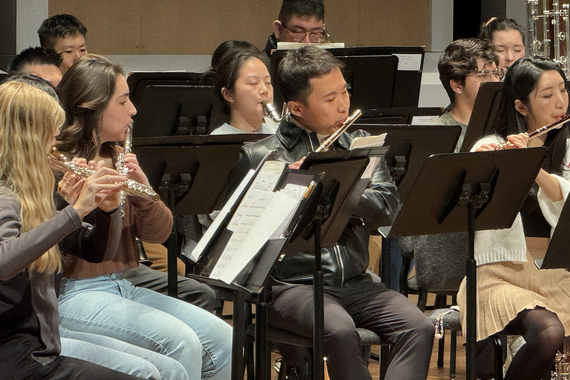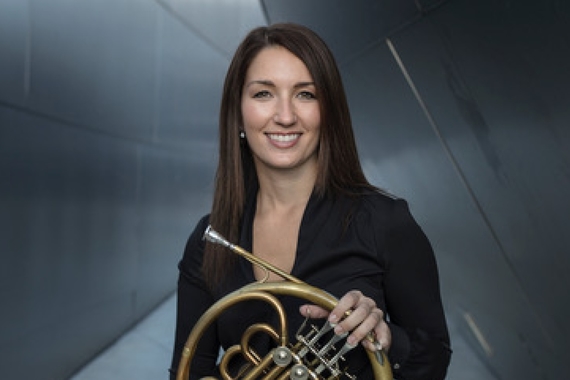Composition Student Jay Afrisando Pursues Developments in Sound Technology and Music Accessibility With Jerome Hill Artist Fellowship
Earlier this year, student Jay Afrisando (PhD, composition, Alex Lubet; advisor) was honored with the prestigious Jerome Hill Artist Fellowship. Hill, an Academy Award-winning filmmaker, painter, photographer, and composer, was born in Saint Paul Minnesota, and continued his career in New York City, California, and France. The grant honors his legacy by supporting emerging, early-career artists, like Afrisando, in Minnesota and New York City.
Afrisando plans to utilize this grant to further his career and artistic development in the areas of sound and technology as they relate to nature. He additionally wants to make music more accessible to those in deaf communities. Recently, we checked in with Afrisando to learn more about his work and his experience with the fellowship application process.
What inspired you to apply for the Jerome Hill Artist Fellowship?
JA: Jerome Hill Artist Fellowship supports artists not only to create and present new works but also to work on artistic development and personal development. I consider those things crucial for emerging artists. Also, I have been at the ABD (All But Dissertation) that has made me eligible for the Fellowship. That’s why I took the chance to apply.
Tell us about the project you are working on for the Fellowship.
JA: My artistic works are aimed to invite others to (re)examine human relationships to other living entities, nature, and technology. Therefore, the projects I am doing for the two-year Jerome Hill Artist Fellowship correspond to those notions.
In two years, I plan to make new compositions such as ambisonics composition (360° or full-sphere audio work) and other fixed media compositions that can be presented on both multichannel loudspeakers and headphones. I will also explore other compositional ideas to create new works.
For my artistic development, I also take the chance to learn digital visual programming to add and enhance my artistic palettes; dive deeper into recording, mixing, and mastering; and collect site-specific nature sound recordings.
For my career development, I am learning ASL (American Sign Language) to learn more about deaf cultures and be able to communicate with deaf communities. I also hope to make music using ASL in the future, creating a more inclusive music ecosystem and exploring accessibility as an artistic approach. I also do website re-design and maintenance for marketing purposes and plan to attend a music conference to present my new composition(s) next year in person, if the condition allows.
What is something surprising that you have learned or experienced so far?
JA: It is not a surprising experience but rather expected, that this Fellowship has unlocked many chances for me to create new works, learn new skills that can support my career as a composer and sound artist, and gain more experiences along with the process.
For now, there is one thing that I can share. In the first three months of the Fellowship, I am working on an ambisonics composition featuring soundscapes of birds and other nature sounds. For that reason, I researched wildlife (especially birds) and sound recording in some of Minnesota’s state parks, mainly coniferous and deciduous forests, and other public spaces. The Fellowship has also enabled me to have new equipment to facilitate this research.
I found that the state parks’ soundscapes are rich, quiet, and fragile, depending on the time I was there. Every early morning, I visited some of the areas around the state parks when wildlife makes many calls and human beings are typically still in their RVs and tents. My favorite moment is the Lake Itasca in the morning. It was one of the quietest environments I have ever experienced in my life. At that time, I felt no wind gusts. The overall sound was spacious and soft. Distant huge dawn choral could be heard faintly. Common loons, crows, and other birds made calls sparsely. All of these sounds echoed, enveloped by the whole lake, the nearby trees, the water, and the mist. I got a chance to set up my recording gears, but the loudness was so low—which is a good thing!—that the mics couldn't even accurately capture the beauty of the whole acoustic environment.
That was certainly not the first time I was immersed with biophony (sounds produced by living organisms residing in a particular biome). During the spring and early summer, my apartment is surrounded by northern cardinals, American robins, black-capped chickadees, crows, Canadian geese, and occasionally downy woodpeckers, blue jays, and yellow-bellied sapsuckers. However, with so much human-made noise around my life, experiencing nature sounds, especially the quiet ones like state parks, has definitely raised my understanding of acoustic environment and being a more responsible human being towards the environment. I found it sad, though, that we still depend on machines, like small aircraft, jet skis, snowmobiles, and other loud machines to navigate natural environments.
As an artist working with sound, I have the responsibility to share this awareness with our society through my artistic works. We really should be thankful to those species. Climate change is real, and every time the wildlife is impacted, we—humans—are at great risk.
Were there any influential instructors that assisted you during the application process?
JA: One of the Jerome Hill Artist Fellowship application’s requirements is to provide a list of works that were created outside academic years, meaning the years before I started my study at the University of Minnesota.
However, the support and assistance that I got from the School of Music and the University of Minnesota, in general, helped me prepare my application. During my study at the University of Minnesota from Fall 2016 up to now, I have written some proposals for grants provided by the School of Music and the COGS (Council of Graduate Students). In my grant proposal writings, my academic advisor, Prof. Alex Lubet helped me with suggestions and insights on how to articulate my artistic ideas into a good proposal. Yan Pang who was one of my fellow composition students at the School of Music also helped give me insights to write competitive project proposals that can steal the reviewer’s attention.
A few semesters ago, I also attended workshops provided by the University of Minnesota including a grant proposal writing workshop that has helped me in preparing any proposals I have been writing and a data management workshop that has been helpful to manage data in my CV and resume.
Although I prepared my application without direct involvement of the faculty at the School of Music and the University of Minnesota in general, the suggestion and insights that I previously got from them were essential for my Jerome Hill Artist Fellowship application.
Is there anything you want the general public to know about your work?
JA: I use sound and other media to share awareness on complex issues that emerge as a result of the ever-changing tools or technology we make and the bodily diversity we have. As human beings, we are equipped with cognitive systems and hearing apparatuses that create diverse hearing profiles. At the same time, the tools we make and/or use eventually make us. Both these matters bring about many consequences, from seemingly simple to complicated ones, for instance on hearing and listening, disability and accessibility, politics on technology and science, cultural issues, and so forth.
My artistic works capture and convey these varied phenomena through various media including but not limited to audio and audiovisual, 2D and 3D, participatory, improvisation, and fixed media works. My works invite others to (re)examine our relationships to other living entities, nature, and technology.
How did your education at the School of Music prepare you for this project?
JA: School of Music has prepared me a lot for this Fellowship and for any projects I have been working on.
The knowledge, facilities, networking, and support from the School of Music and the faculties, especially my academic advisor, Alex Lubet, have contributed immensely to my career and future. It is a privilege to have an academic advisor who is not only supporting me academically but also support me as an artist, and to interact with my academic peers and artists in many fruitful discourses.
Learn more about the Jerome Hill Artist Fellowship here. Explore more of Jay Afrisando’s work on his website.
![School of Music Student Jay Afrisando. Text: [the sound of thinking]](/sites/cla.umn.edu/files/styles/feature_image/public/20210713_jayafrisando_bee_lab_caption.png?h=d1cb525d&itok=IxikSGT2)


